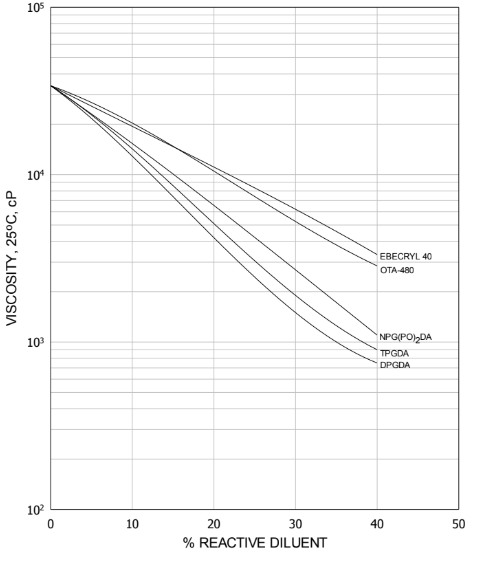Enhanced TDS
Identification & Functionality
- Blend
- No
- CASE Ingredients Functions
- Chemical Family
- Function
- Oligomer, Monomer
- Product Code
- MITM00462
- Single Ingredient
- Yes
- Technologies
- Product Families
Features & Benefits
- CASE Ingredients Features
- Performance Highlights
EBECRYL®885 is characterized by:
- Moderate viscosity
- Good reactivity
UV/EB curable formulated products containing EBECRYL®885 are characterized by:
- Excellent abrasion resistance
- High flexibility
The actual properties of UV/EB cured products also depend on the selection of the other formulation components such as oligomers, additives and photoinitiators.
Applications & Uses
- Applicable Processes
- Coating End Applications
- Compatible Substrates & Surfaces
- Cure Method
- Markets
- Applications
- Product Application
EBECRYL®885 is recommended as for in:
- Parquet flooring
- Furniture coatings
- Metal coatings
- Plastic coatings
- Resilient flooring
Properties
- Physical Form
Technical Details & Test Data
- Viscosity Reduction
GRAPH I:EBECRYL®885 - VISCOSITY REDUCTION WITH REACTIVE DILUENTS

- Graph I shows the viscosity reduction of EBECRYL®885 with 1,6-dipropylene glycol diacrylate (DPGDA)¹ , neopentyl glycol propoxylate diacrylate (NPG(PO)2DA)¹ , tripropylene glycol diacrylate (TPGDA)¹ propoxylated glycerol triacrylate (OTA- 480)¹and EBECRYL 40¹.
- Although viscosity reduction can be achieved with non- reactive solvents, reactive diluents are preferred because they are essentially 100 percent converted during UV/EB exposure to form a part of the coating, thus reducing solvent emissions.
- The specific reactive diluents used will influence performance properties such as hardness and flexibility.
- ¹ Product of Allnex
Safety & Health
- Safety Precautions
- Avoid contact with eyes and skin.
- Direct contact with this material may cause moderate eye and skin irritation.
- Contact with skin may cause a cross-allergic reaction in persons already sensitized to acrylate materials.
- Wash thoroughly after handling.
- Keep container tightly closed.
- Use with adequate ventilation.
Packaging & Availability
Principal Information
- Group Principal Number
- S000001
- Principal
Storage & Handling
- Storage and Handling Conditions
- The recommended storage temperature range for EBECRYL®885 is 4°C to 40°C (39°F to 104°F).
- Care should be taken not to expose the product to high temperature conditions, direct sunlight, ignition sources, oxidizing agents, alkalis or acids.
- This might cause uncontrollable polymerization of the product with the generation of heat.
- Storage and handling should be in stainless steel, amber glass, amber polyethylene or baked phenolic lined containers.
- Procedures that remove or displace oxygen from the material should be avoided.
- Do not store this material under an oxygen free atmosphere.
- Dry air is recommended to displace material removed from the container.
Other
- Appearance
- Clear pale yellow liquid
- Appearance (SDS)
- Liquid
- Color (SDS)
- Yellowish
- Item Number
- Odor (SDS)
- Ester acrylate
- Other Hazards
- Polymerization may occur from excessive heat, contamination or exposure to direct sunlight .
- Protect from Freezing
- Yes
- Temperature Control
- Yes
- USA/DOT UN Number
- Not Applicable
- Chemical Properties
Value Units Test Method / Conditions Acid Value max. 15.0 mg KOH/g mg KOH/g - Material Composition
Value Units Test Method / Conditions Oligomer Content 100.0 %(W/W) %(W/W) - Mechanical Properties
Value Units Test Method / Conditions Elongation 44.0 % % at break, UV cured 80 μ thick films Tensile Modulus 18.0 MPa MPa UV cured, 80 μ thick films Tensile Strength 3.5 MPa MPa UV cured, 80 μ thick films - Optical Properties
Value Units Test Method / Conditions Color Scale max. 2.0 Gardner Gardner Gardner Color Scale - Physical Properties
Value Units Test Method / Conditions Density 1.19 g/mL g/mL at 25°C Flash Point min. 100.0 °C °C Setaflash Glass Transition Temperature (Tg) 21.0 °C °C UV cured, 80 μ thick films Storage Temperature 39.2-104.0 °F °F Viscosity 30000.0-45000.0 mPa.s mPa.s at 25°C - SDS Physical and Chemical Properties
Value Units Test Method / Conditions Boiling Point (SDS) min. 100.0 °C °C Density (SDS) 1.19 g/cm³ g/cm³ Flash Point (SDS) min. 110.0 °C °C SetaFlash Closed Cup Storage Temperature (SDS) 4.0-40.0 °C °C Volatile Content (SDS) max. 0.5 % % - Shelf Life & Stability
Value Units Test Method / Conditions Shelf Life 0.0 d d
